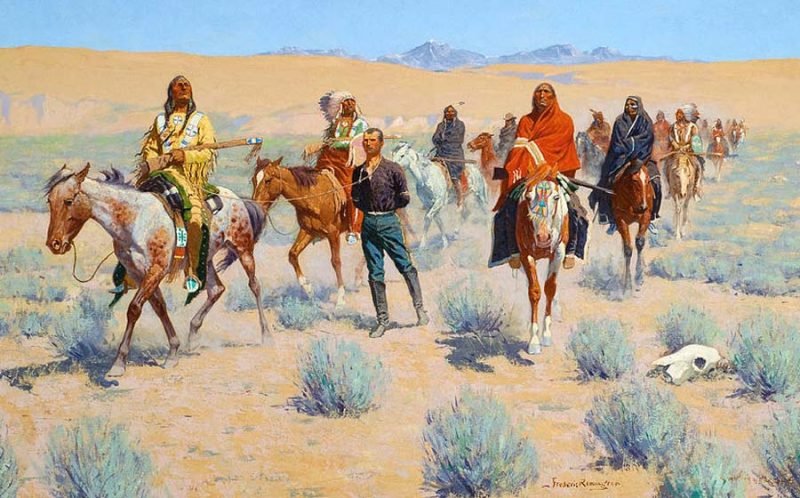
Most art historians and critics regard Frederic Remington (1861–1909) as one of the most gifted painters of the American West. He started his career by providing images of the American West as illustrations in popular journals.
However, later in his career, he turned away from illustration. Instead, he started to concentrate on painting and sculpture. In this article, we’ll look at some of his famous paintings to give you an idea of his excellent work.
Learn About Frederic Remington’s Art
Before we look at a few specific paintings by the famous artist Frederic Remington, let’s discuss a few general aspects of his work. When he started as a professional painter, he primarily produced ink and wash drawings in black and white for commercial reproduction. As he developed as an artist, he started to create watercolors. He also began to sell his work at art exhibitions.
In principle, Frederic Remington was inspired by the interaction between a cowboy and his horse. Furthermore, he was intrigued by the simple and humble life of the cowboys. Cowboys and horses were his favorite subjects. Remington’s attitude toward Native Americans was typical for the time. While he always portrayed white men under attack as brave and noble, he believed Native Americans were unfathomable, superstitious, ignorant, and pitiless. Usually, he portrayed them as such in his paintings.
Remington was also the first American painter who successfully depicted horses in full gallop anatomically correct. Earlier artists usually depicted galloping horses with all four legs pointing out, while Remington captured the movement of galloping horses correctly.
One of the important later developments in Frederic Remington’s art was his exploration of painting darkness – we’ll discuss this later in this article. Now, look at some of the artist Frederic Remington’s famous paintings.
His Last Stand
“His Last Stand” was created in 1890. It depicts a cornered bear in the middle of a prairie. Dogs and riflemen have brought the bear down on horseback. The painting was well-received by art lovers and art critics as a “typical American West scene”.
Later on, many art historians tried to link this painting with Remington’s view of the Native Americans. The historians saw the painting as a symbolized treatment of the dying Native Americans he witnessed.
But there are also many art lovers and critics who just see the work as a depiction of “everyday life” in the American West of that time.
A Dash for the Timber
This is one of the very famous Remington paintings. “A Dash for the Timber” shows a group of cowboys riding at full gallop, trying to escape a group of American Indians chasing them on horseback.
In this painting, the horses’ leg positions and leg movements are depicted correctly. As a result, the galloping horses seem as if captured at a specific moment in time. Many other artists have since copied this way of depicting galloping horses.
This famous Remington painting was created in 1889 when he was only 28 years old. Galloping horses and cowboys on horseback was Remington’s signature subject.
Return of the Blackfoot War Party
When Remington exhibited “Return of the Blackfoot War Party” (1887) at the National Academy of Design, it was received very well by art lovers and critics. He was seen as a talented new artist.
An art critic of the “New York Herald” even commented that Remington would become one of the great American painters. He based his comment basically on the ability Remington showed to handle complex compositions.
Mule Train Crossing the Sierras
Another famous painting by artist Frederic Remington is “Mule Train Crossing the Sierras” (1888). He also showed his ability to handle complex compositions easily in this painting. In addition, the painting depicts action from all points of view.
Because he won a second-class medal at the Paris exhibition with this painting in 1889, it was an important painting for him at that time – it contributed to his status as the new trendsetter in Western American art.
The Fall of the Cowboy
Because Frederic Remington knew that the American West with its cowboys would disappear sometime or other, he created the painting “The Fall of the Cowboy” in 1895″. The Fall of the Cowboy” has become one of the most famous Frederic Remington paintings because with it he honored all the cowboys of the past.
The painting symbolizes the end of the American West cowboy era. Yet, with the painting, he showed respect for the important symbol of freedom that was disappearing fast in the American West.
In “The Fall of the Cowboy” , Remington conveyed that cowboys had been reduced to “gate openers” due to industrialization. This is in contrast with the traditional life of the cowboys without barriers.
The two cowboys in the picture are going to the other side of the fence. Art historians speculate that the snow in the painting symbolizes “winter” that has arrived for cowboy life. However, other art critics interpret the painting more positively. According to them, the painting symbolizes that when you leave one era, another new era might be awaiting you.
Frederic Remington Night Paintings
Later in his career, Remington explored the technical and aesthetic difficulties of painting darkness. He created a series of works with “the color of night” as the subject. With the paintings, he captured the silver tones of moonlight, the hot color of the flame of firelight, and the “soft” light of a candle.
The paintings are also seen as metaphoric because they were created just as electricity began to alter the atmosphere and character of the night. According to art historians, his use of “color in darkness” resulted from his interest in modern technological innovations. He was very interested in flash photography and electricity.
Clearly, Frederic Remington’s “darkness paintings” are full of color and light. He depicted scenes with moonlight, firelight, and candlelight. His later “darkness” paintings also reflect that the artist Frederic Remington knew the cowboy world he had known as a young man was disappearing. Nowadays, many of his nocturnal works are regarded as deeply personal paintings.
A list of Frederic Remington’s night paintings includes the following famous paintings:
- “On Guard at Night”
- “The Hunters’ Supper”
- “The Night Herder”
Conclusion
We hope that this quick look at some of the famous Frederic Remington paintings entices you to search for more of his paintings and, if you are a collector, to acquire one or more Remingtons for your gallery.









